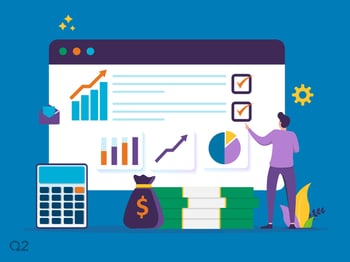By Taylor Adkins, VP of Product
As small businesses continue to weather the pandemic, another relief package containing $285 billion in Small Business Administration (SBA) Paycheck Protection Program (PPP) funds is officially on its way. This is good news for businesses across the country, our communities, and our economy—but distributing the funds is no easy task, and participating financial institutions are all-hands-on-deck to prepare before loan applications flood in.
To date, PPP has been both a big opportunity for lenders and an administrative nightmare. On the eve of the next wave, many lenders are feeling “PPP fatigue.” The constantly changing guidelines from the SBA, overwhelming volume of loan applications, and painstaking manual processes have pushed FI staff to their limits. And with the third round of PPP looming, fatigued lenders are wondering what to expect and how to prepare.
As a vendor of PPP solutions, we’ve had the opportunity to speak with the SBA about round three—and to help you prepare, we’re sharing a few key things we know (and don’t know) now:
Repeat borrowers are eligible for another round of funding.
For the first time, borrowers who received a PPP loan in a previous round can apply for more aid. This means demand for PPP loans will likely remain high. It may also create challenges or a poor experience for repeat borrowers; many lenders processed applications and loans manually in previous rounds and will likely have to treat repeat borrowers as brand new, collecting and recording their information all over again. Those who used technology solutions to automate this process already have their borrowers’ data and documentation in place, making it a quicker and smoother trek. No one can say if this will be the final wave of PPP funding, but lenders with a single, digital source of truth will have a much easier time processing applications for repeat borrowers. With an adequate digital solution on the front end, they’ll have a big leg up on the back end—think loan forgiveness! And for those who don’t, it’s never too soon to begin gathering what documentation and details they did manage to retain from the previous PPP waves.
Expect slower processing and increased scrutiny.
Fraud, misuse of funds, and other complications from previous rounds have pushed the SBA to apply more scrutiny to loan approval this time. And on top of that, it doesn’t appear that loans will be processed straight-through as they were in 2020. The result? The SBA is advising lenders and borrowers to expect substantial delays in fund processing relative to the last few rounds of PPP—expressing that access to funds could take days, weeks, or even months. And with increased scrutiny, we expect more applications to be denied by the SBA, contrary to initial rounds where a completed application was almost certain to be approved.
Again, this means getting applications right on the front end will pay off substantially on the back end. Lenders who screen applications for eligibility early, according to the new SBA guidelines, will save themselves from processing applications they know will be rejected, improving their ability to focus on loans and borrowers that will result in funds. And of course, screening applications early in the process will allow lenders to set better expectations with their borrowers, so they know when they can expect funding (or whether to expect it at all).
There’s still ambiguity from the SBA.
Perhaps our biggest finding in early discussions with the SBA is that many of the rules and processes for PPP round three are still in flux. Many of the most pressing details—like how lenders will be required to submit applications to the SBA—are still being sorted through. Bulk application submissions, for example, are likely going away; whether the SBA will continue to use E-Tran is still in question. For hardened SBA lenders, or financial institutions that have participated in PPP prior, the ever-changing rules of play are nothing new—but this time around, even the most central processes for submission and approval are in question.
The bottom line is that lenders looking to participate in PPP again will need to be agile. That’s something we’re proud of in our PPP solution: we incorporate changes from the SBA on the fly on behalf of our customers, taking much of the burden of “keeping up” off lenders and their staff. Fortunately, a digital PPP solution isn’t a “one and done” fix, but can instead be the gateway that expands an FI’s product offerings and community impact from end-to-end.
Overall, lenders should anticipate different challenges this time around, with increased scrutiny and slower processing making fund availability all but certain at this moment. We expect to continue learning more from the SBA in rapid fashion as the program progresses, so stay tuned.
To learn more about what our lending experts are doing to make PPP more manageable for our customers, visit http://learn.q2.com/ppp.




